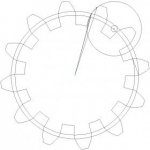you can make a button cutter and then make another cutter and then cut the teeth..
or you can just generate the radius in the gear tooth directly with 2 dowel pins, a plate with 3 holes in it, a plate with 1 center hole and the number of holes needed for indexing each tooth,
and a movable axis to locate a dowel pin an adjustable distance from a grinding wheel, which has to be dressed thin enough to fit between the gear teeth. (as the grinding wheel wears down you need to adjust the dowel pin closer to the stone).
use a cad program to find the optimal radius and location to generate the approximation of the involute. (and then drill that hole into the intermediate plate that holds the indexing plate.
you set the gear blank on top of the indexing plate and rotate it into the grinding wheel, rotate it away, lift the gear off the indexing plate, rotate the blank 1 tooth and do it again (obviously it would be best to use a ball end mill to cut out the root of each tooth first). you then flip the gear over to generate the other side of the teeth.
so this is really a reply to the other guy who needed an 8 dp gear which is close to mod 3:
when i plotted the angular error of an involute (12 tooth, 20 degree pressure angle, no funny stuff) compared to a simple radius, the error is a minimum of about .09 degrees. just by eyeballing the matter i was able to get an error of .08 degrees and .1 degrees.


so one problem is finding a creative way to flip the gear over while using the same hole for the radius generator so both sides of the gear are generated at the same radius. one option is drilling the indexing holes all the way through the gear blank. if they are small enough and located in the center of the tooth, the gear will not be weakened significantly. if the indexing holes are below the base circle the gear won't be weakened but the gear won't be as accurate because of the fixed error that you get from drilling a standard hole (no one has the time to drill and bore the indexing holes if we're only approximating the involute with a single damn radius)
you could dimple the gear teeth on the face of the gear on the end of the tooth and use a ball plunger to index each tooth.. but this will only work on larger gears bigger than mod 2 or 12 dp unless you can use tiny drills and tiny ball plungers.
a standard 8" diameter grinding wheel is probably good up to a gear of 1/2" thickness. above this, the grinding wheel is going to bottom out in the middle of the root between the teeth and this will weaken the gear, concentrating forces in the edges of the roots of the teeth.
another possibility is that you simply drill the root of the tooth with a drill bit, and use those holes as the index. put the dowel pin which fits into the root of the tooth blanks far enough away so it doesn't run into the grinding wheel.




 Seriously though, it is nice to know that should I need a certain gear in a rush situation and don't have the cutter, I'll have a way to get it done.
Seriously though, it is nice to know that should I need a certain gear in a rush situation and don't have the cutter, I'll have a way to get it done.

